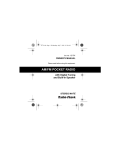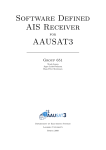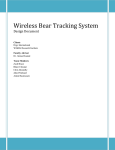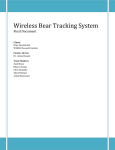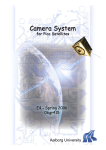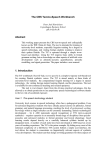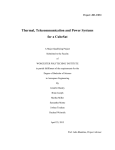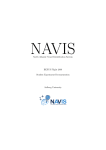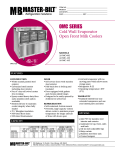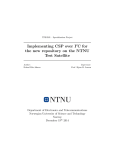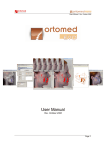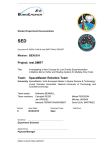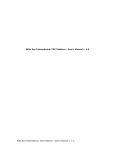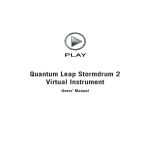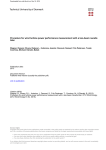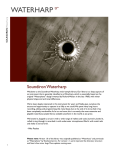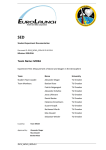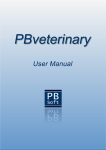Download AIS receiver for BEXUS - AAUSAT3
Transcript
Appendix To worksheets by 09gr721 - A continuing of the SED documentation for ESA started in January 2009 and continued since summer 2009 by 09gr721. Schematics for all subsystems can be found in the pdf included on the CD for Group 3 (09gp721) NAVIS North Atlantic Vessel Identification System BEXUS Flight 2009 Student Experiment Documentation (Lite Version) Aalborg University Change Record Document Revisions Version 0-0 0-1 0-3 0-4 1 2 3 3 4 4.1 Date 03/01/2009 03/04/2009 03/15/2009 03/15/2009 03/15/2009 05/24/2009 08/09/2009 08/27/2009 10/11/2009 12/15/2009 Changed chapters All All All All All All See note 1 See note 2 All Remarks Latex template created Document started First internal review Comment from JDN Preliminary Design Review (PDR) Critical Design Review (CDR) Mid-Term Report (MTR) v. 1 Mid-Term Report (MTR) v. 2 Launch campaign Lite version created as worksheets Note 1 • new schematics added (Not Included in Lite Version) • pictures of integration (Not Included in Lite Version) • Antenna Requirements added section 2.1 • Status updated • Minor updates Note 2 Appendix C contains the comments from the CDR, and has been updated with references to the answers. • Changed: Section 3.3.2, Bexus Mountings • Added: Section 3.4.1, Active heating • Added: Section 3.5.1, Battery test Future Document Revisions Version 5 Date Changed chapters XX/XX/2009 Remarks Final report i Abstract: This is the NAVIS project SED (Student Experiment Documentation). The objective of this project is to test two experimental radio receivers and decoders for the maritime vessel tracking system AIS. Through the BEXUS project, these receivers has been granted a flight on the high altitude balloon flight in October 2009, where the receivers’ capabilities will be tested at altitudes up to 35 km. The first AIS receiver is build using a single chip radio receiver, the Analog Devices ADF7021. A second AIS receiver is a software defined radio, based on a Blackfin DSP. NAVIS is a subproject of AAUSAT3, the 3rd Cubesat currently being developed at Aalborg University, Denmark. The main payload is the two AIS receivers, and the NAVIS project BEXUS flight is a key milestone for AAUSAT3 - the first high altitude test of the AAUSAT3 prototype v. 1.0. The two AIS receivers has been designed and developed at Aalborg University by group 09gr650 and 09gr651. More details may be found in the attached semester reports (attachments (Not Included in Lite Version)). Likewise the UHF link has it’s own detailed report. Keywords: SED BEXUS09 AIS AAUSAT3 AAU SDR ii Table of Contents Preface v 1 Introduction 1.1 Experiment Objectives . . . . 1.2 Experiment Overview . . . . 1.3 Scientific Support . . . . . . . 1.4 Similar scientifically projects 1.5 Team Organisation . . . . . . . . . . . . . . . . . . . . . . . . . . . . . . . . . . . . . . . . . . . . . . . . . . . . . . . . . . . . . . . . . . . . . . . . . . . . . . . . . . . . . . . . . . . . . . . . . . . . . . . . . . . . . . . . . . . . . . . . . . . . . . . . . . . . . . . . . . . . . . . . . . . . . . . . . . . . . . . . . . . . . . 1 1 2 4 5 5 2 Mission Requirements 2.1 Antenna Requirements . . 2.2 Technical Requirements . 2.3 Functional Requirements . 2.4 Operational Requirements . . . . . . . . . . . . . . . . . . . . . . . . . . . . . . . . . . . . . . . . . . . . . . . . . . . . . . . . . . . . . . . . . . . . . . . . . . . . . . . . . . . . . . . . . . . . . . . . . . . . . . . . . . . . . . . . . . . . . . . . . . . . . . . . . . . . . . . . 9 9 9 9 10 3 Experiment Description 3.1 Experiment Overview . . . 3.2 Experiment Setup . . . . . 3.3 Mechanical Design . . . . . 3.4 Thermal Design . . . . . . . 3.5 Power System . . . . . . . . 3.6 Experiment Control System . . . . . . . . . . . . . . . . . . . . . . . . . . . . . . . . . . . . . . . . . . . . . . . . . . . . . . . . . . . . . . . . . . . . . . . . . . . . . . . . . . . . . . . . . . . . . . . . . . . . . . . . . . . . . . . . . . . . . . . . . . . . . . . . . . . . . . . . . . . . . . . . . . . . . . . . . . . . . . . . . . . . . . . . . . . . . . . . . . . . . . . . . . . . . . . . . . . . . . 13 13 18 19 23 26 28 4 Review and Test 4.1 Experiment Selection Workshop (ESW) 4.2 Preliminary Design Review (PDR) . . . 4.3 Critical Design Review - CDR . . . . . . 4.4 Experiment Acceptance Review - EAR . 4.5 Test Plan . . . . . . . . . . . . . . . . . . . . . . . . . . . . . . . . . . . . . . . . . . . . . . . . . . . . . . . . . . . . . . . . . . . . . . . . . . . . . . . . . . . . . . . . . . . . . . . . . . . . . . . . . . . . . . . . . . . . . . . . . . . . . . . . . . . . . . . . . . . . . . . . . . . 31 31 31 31 31 31 5 Launch Campaign 5.1 Experiment Preparation . . . . . . . . . 5.2 Experiment Time Event During Flight . 5.3 Operational Data Management Concept 5.4 Flight Readiness Review - FRR . . . . . 5.5 Mission Interference Test - MIT . . . . . 5.6 Launch Readiness Review - LRR . . . . 5.7 Inputs For The Flight Requirement Plan 5.8 Post Flight Activities . . . . . . . . . . . . . . . . . . . . . . . . . . . . . . . . . . . . FRP . . . . . . . . . . . . . . . . . . . . . . . . . . . . . . . . . . . . . . . . . . . . . . . . . . . . . . . . . . . . . . . . . . . . . . . . . . . . . . . . . . . . . . . . . . . . . . . . . . . . . . . . . . . . . . . . . . . . . . . . . . . . . . . . . . . . . . . . . . . . . . . . . . . . . . . . . . . . . . . . . . . . . . . . . . . . . . . . . . . 35 35 36 37 37 37 37 37 39 6 Abbreviations and References 43 iii TABLE OF CONTENTS 6.1 Abbreviations . . . . . . . . . . . . . . . . . . . . . . . . . . . . . . . . . . . . . . . . . A Subsystem A.1 EPS . A.2 LOG . A.3 FPF . A.4 UHF . A.5 ELA . A.6 AIS1 . A.7 AIS2 . requirements . . . . . . . . . . . . . . . . . . . . . . . . . . . . . . . . . . . . . . . . . . . . . . . . . . . . . . . . . . . . . . . . . . . . . . . . . . . . . . . . . . . . . . . . . . . . . . . . . . . . . . . . . . . . . . . . . . . . . . . . . . . . . . . . . . . . . . . . . . . . . . . . . . . . . . . . . . . . . . . . . . . . . . . . . . . . . . . . . . . . . . . . . . . . . . . . . . . . . . . . . . . . . . . . . . . . . . . . . . . . . . . . . . . . . . . . . . . . . . . . . . . . . . . . . . . . . . . . . . . . . . . . . . . . . . . . . . . . . . . . . . . . . . . . . . . . . . . . . . . . . . . . . . . . . . . . . . . 43 45 45 46 46 47 47 47 48 B PDR Comments 51 C CDR Comments 53 Bibliography 55 iv Preface The SED (Student Experiment Documentation) provides EuroLaunch and other readers with all important information about the NAVIS (North Atlantic Vessel Identification System) experiment from Aalborg University. During all experiment phases - development, experiment production, launch campaign and post flight - this SED is the place to find documentation that describes the experiment in detail. The SED is built on the basis of ”Guidelines for Student Experiment Documentation”. In this version 2 of the SED, nearly all chapters are altered, and more information has been put to this document, as well as the budgets has been adjusted. A special focus has been on the mechanical system, which was poorly documented in the first version of this SED. Also note that AIS2 subsystem has changed its computing platform to an Analog Devices DSP. The NAVIS experiment was formerly known as ”AAUSAT3 AIS receiver”. The goal of the NAVIS experiment is to test two student developed AIS receivers, as a milestone in the development of the 3rd Cubesat from Aalborg University. The NAVIS team can be contacted at [email protected]. Our website is located at http://navis-project.eu. Author Signatures Hans Peter Mortensen Jeppe Ledet-Pedersen Mads Hjorth Andersen Nikolaj Pedersen Troels Jessen Troels Laursen Ulrik Wilken Rasmussen v Chapter 1 Introduction 1.1 Experiment Objectives The Danish Maritime Safety Administration’s (DaMSA) mission is to have the safest seaways in the world. They are well underway in the Danish waters, but around Greenland, which is also DaMSA’s area of responsibility, the waters are not perfectly charted. To build a tracking system around Greenland will be an enourmase task due to the size of Greenland and the hostile environment. Therefore DaMSA would like to track the ship traffic by Automatic Identification System (AIS) as they are doing in Denmark, so that they know where to concentrate their charting activities. A short introduction to AIS for readers who are unfamiliar with the system is found in Appendix (Not Included in Lite Version) DaMSA traditionally tracks ships via AIS by placing ground stations on the shores, to receive transmissions from the ships, but also to act as electronic lighthouses. This method is impractical in the regions around Greenland and will still not cover the open seas, as the ground stations can not receive transmissions from ships beyond the line of sight. Ground stations typically receives signal from approximately 40 nautical miles away (74 km.)[Cervera 08]. AAUSAT3 is the third student satellite developed at Aalborg University. The satellite’s mission is to evaluate the possibilities of receiving AIS messages from ships via satellite as a preliminary step in the development of operational AIS satellites. By analyzing the communication path from ship to satellite, it has been estimated that it is possible to receive AIS signals in both 35 km altitude (Appendix (Not Included in Lite Version)) and in Low-Earth Orbit (LEO). Figure 1.1: AAUSAT3 communication path The main objective of the NAVIS project is to test the ability of two student developed AIS receivers to receive and decode real life AIS radio signals in high altitude. As the receivers are designed for AAUSAT3 a number of natural restrictions applies such as size, weight, power consumption and general robustness of the construction. Based on the outcome of the BEXUS flight, the final design of the primary payload of AAUSAT3 will be selected. The balloon flight will include an adapted 1 CHAPTER 1. INTRODUCTION Engineering Model (EM) of AAUSAT3, to test the satellite design. 1.2 Experiment Overview The AIS system was originally only intended to be used for ship-to-ship and ship-to-land transmission. This design raises some challenges when receiving signals in space. A satellite will be able to receive AIS messages from a much larger area than a ground station, due to the increased altitude and thereby line-of-sight. This means that a satellite might receive collided AIS massages, due to the fact that a ship only synchronizes its transmissions with other ships within the line-of-sight. This problem is illustrated in Figure 1.2. Figure 1.2: Each circle represents a possible ship synchronization zone. When receiving from high altitude more than one zone will be in the satellites footprint. An altitude of 35 km will give a footprint radius of approximately 650 km (Appendix (Not Included in Lite Version)). Today no AIS receivers is known to be in operation in space. One commercial LEO experiment of lower complexity than the AAUSAT3 AIS receivers exists, but the results are not published, so getting a functional AIS receiver in high altitude will be breaking news [COM DEV International 07]. The expected outcome of the NAVIS project is a test of the AIS systems, collection of raw AIS data and a test of the general AAUSAT3 structure. DaMSA will provide reference AIS data from land based stations in the relevant area for comparison. It is of high scientific interest to get access to raw data as well as test the AIS signal decoding algorithms for both students and researchers at Aalborg University. The data obtained will be further analyzed in master projects as well as by researchers at the university. 1.2.1 Experiment subsystems The experiment is developed with two different solutions to receive AIS from AIS transponders. This is done for testing how the two different solutions will react due to the climate and to compare the two solutions for further development. Because the two AIS system are redundant, it raises the reparability for a success, even if one of the systems will malfunction. The experiment is divided into the following subsystems: • Hardware AIS receiver • Software AIS receiver 2 1.2. EXPERIMENT OVERVIEW • Splitter • UHF radio • E-link adapter • Platform system This is illustrated in Figure 1.3. RF Front-end Software AIS Receiver E-Link Adapter RF Receiver Hardware AIS Receiver Platform System UHF Transceiver UHF Radio E-Link Splitter Batteries Figure 1.3: System flowchart In order to keep the system as modular as possible, the internal communication is handled by CAN Space Protocol (CSP), a CAN (Controller Area Network) protocol developed at Aalborg University for use in AAUSAT3. The protocol enables socket-like communication between all subsystems simply by assigning addresses to subsystems and ports to services. Hardware AIS receiver (AIS1) The goal of AIS1 is to receive AIS using a well know and thoroughly tested technology. AIS1 consist mainly of a COTS hardware receiver and demodulator. The selected general purpose receiver must be configured both by external discrete components and by software to the right frequency and modulation scheme. This receiver will use an MCU to handle the AIS protocol. More information about the AIS protocol is found in Appendix (Not Included in Lite Version). Software AIS receiver (AIS2) The AIS2 will use a hardware down converter and sample the low Intermediate Frequency (IF) output. A Digital Signal Processor (DSP) is used for filtering and demodulation of the data. This allows advanced demodulation algorithms to be tested and permits in-flight reconfiguration and optimization of the algorithms in space. AIS2 is able to store raw sampled data to be used for development, optimization and algorithms evaluation on ground after the BEXUS flight. Splitter The purpose of the splitter is to distribute the received signal from one antenna to the two AIS subsystems. Furthermore, the splitter contains components for amplification and filtering of the signal. E-Link adapter (ELA) The ELA acts as a gateway between the BEXUS E-Link, and the internal CAN. By using both E-Link and the AAUSAT3 UHF Transceiver, the experiment will have redundant communication channels. 3 CHAPTER 1. INTRODUCTION Platform system The Platform system will handle battery management, power conversion, distribution and measurements. Furthermore the Platform system will act as a subsystem watchdog timer and enable remote monitoring and power control of the individual subsystems. The subsystem also contains a system log and the flight plan, which can be modified during flight. UHF Transceiver The UHF radio is an experiment in itself and is based primarily on the work of a master thesis started in 2008 and ended in may 2009. The thesis focuses on the development of a new radio system for amateur spacecrafts and uses a simple off-the shelf radio platform with new coding techniques to obtain a large improvement over traditional radio systems. Flying the UHF radio on the high altitude baloon will influence the system in ways similar to a low-earth-orbit satellite. The goal of the test is to predict and model the effect of these influences and of course be able to maintain a reliable data-link for telemetry. The system uses the AAUSAT-II’s licensed UHF channel at 437.425 MHz using 2FSK modulation. 1.3 Scientific Support NAVIS has support from a number of individuals associated with Aalborg University and DaMSA. The department of Electronic Systems at the university provides supervision for the two project groups, and Center for Software Defined Radio will assist in the implementation of the DSP software for AIS2. The following people will assist the NAVIS project: Hans Ebert Associate professor, Group 09gr650 supervisor. Ole Kiel Jensen Associate professor, Group 09gr651 supervisor. Jens Dalsgaard Nielsen Associate professor, AAUSAT3 project supervisor. Jesper A. Larsen Assistant professor, Assisting AAUSAT3 project supervisor. AAUSAT3 System Engineering group A group consisting of project supervisors and students from each participating group in the AAUSAT3 project. Peter Koch Associate Professor, Head of Center for Software Defined Radio, Aalborg University. Muhammad Mahtab Alam Research Assistant, Center for Software Defined Radio, Aalborg University. Claus Sølvsten Contact person at the Danish Maritime Safety Administration. 4 1.4. SIMILAR SCIENTIFICALLY PROJECTS Daniel Winter Uhrenholt Employee at Aalborg University. Responsible for mechanical design and construction on the NAVIS project. Aalborg University Aalborg University (AAU) offers approx 60 different study programmes and has nearly 14,000 students. Aalborg University Space Center was founded in 2004 by the the Faculty of Engineering and Science. The university was involved in the development of the first danish satellite, Ørsted, which was launched in 1999 and still is operational. The student satellite program has resulted in launch of two Cubesats — one of which is still operartional after more than 1 year in space. Furthermore, students from Aalborg University were highly involved in the European SSETI Express satellite. • Involved in the Ørsted satellite (launched 1999) • AAU CubeSat (launched 2003) • SSETI Express (launched 2005) • AAUSAT-II (launched April 28th 2008 - Still in operation) 1.4 Similar scientifically projects AISsat-1 Norwegian satellite developed for AIS surveillance of the Arctic Sea. Expected launch in 2009-2010. http://www.spacecentre.no/ ComDev/CanX-6 Commercial satellite launced April 2008. Reported to be a success in a press release from June 5th 2008, but no results have been published. http://www.comdev.ca/ ESA research ESA has produced a paper in which the possibility of receiving AIS signals in space is investigated. http://www.dlr.de/iaa.symp/Portaldata/49/Resources/dokumente/archiv5/1304_Hoye.pdf 1.5 Team Organisation The NAVIS team consists of two groups from Aalborg University, studying 6th semester Communication Technology. Group 1 is developing the hardware based AIS receiver (AIS1) and group 2 is responsible for the software AIS receiver (AIS2). The numbers 09gr650 and 09gr651 refers to the internal group numbers at Aalborg University. All students in the project are from Denmark. 3 semester reports was produced in the spring of 2009 documenting in details AIS1, AIS2, and the UHF. see [Christiansen 09] [Jessen 09] and [Andersen 09] 1.5.1 Group 1 - 09gr650 - AIS1 Mads Hjorth Andersen (MH) [email protected] Troels Laursen (TL) [email protected] Nikolaj Pedersen (NP) [email protected] Ulrik Wilken Rasmussen (UW) [email protected] 5 CHAPTER 1. INTRODUCTION (a) Mads Hjorth Andersen (b) Troels Laursen (c) Nikolaj Pedersen (d) Ulrik Wilken Rasmussen Figure 1.4: Portraits of group members from group 1 (a) Troels Jessen (b) Jeppe Pedersen Ledet- (c) Hans Mortensen Peter Figure 1.5: Portraits of group members from group 2 1.5.2 Group 2 - 09gr651 - AIS2 Troels Jessen (TJ) [email protected] Jeppe Ledet-Pedersen (JL) [email protected] Hans Peter Mortensen (HP) [email protected] 1.5.3 Group 3 09gr721 - Modelling AIS Transmission Behaviour With Extended Field Of View Hans Peter Mortensen (HP) [email protected] Troels Laursen (TL) [email protected] Nikolaj Pedersen (NP) [email protected] Ulrik Wilken Rasmussen (UW) [email protected] 1.5.4 Others As part of the AAUSAT3 project, two other students are contributing to the development of subsystems for the NAVIS project: Anders Bech Borchersen (ABB) 6th semester Automation and Control at Aalborg University and is developing the software and Ethernet-CAN protocol for the E-Link Adapter (ELA) in his spare time, is also helping develop the grounstion. [email protected] 6 1.5. TEAM ORGANISATION Johan De Claville Christiansen (JC) 10th semester Networks and Distributed Systems student developing the UHF communication link (COM) for AAUSAT3 wich will also be included in the NAVIS experiment and the communication link will be tested. Johan is developing the UHF subsystem as his masters thesis. [email protected] Morten Tychsen (MT) 8th semester Networks and Distributed Systems has taken over the development of the ELA from Anders because he is now working on groundstation software. [email protected] Benjamin Biegel (BB) 6th semester Automation and Control at Aalborg University working on the EPS software. [email protected] Jesper Abildgaard Larsen (JAL) Lecturer at AAU is assisting with PCB layout. [email protected] Jens Frederik Dalsgaard Nielsen (JDN) Associate professor at AAU supervisor for AAUSAT3 projekt will be helping with media contakt and general advise. [email protected] 7 Chapter 2 Mission Requirements This chapter defines all requirements to perform the NAVIS experiment. Requirements for the individual subsystems is shown in appendix A 2.1 Antenna Requirements It is arranged with ESRANGE that they can provide a ground station antenna and pointing equipment for the NAVIS experiment. This will simplify the transportation of equipment, and ensure that the antenna is pointed correct without allowing the NAVIS team access to the live GPS data stream. The antenna must have a gain at minimum 12 dBi at 437.475 MHz. 2.2 Technical Requirements The experiment will run continuously during the entire balloon flight (Estimated MAX 6 hours). AIS1 stores data from one AIS channel of 9k6 baud, thereby creating the following amount of data on the 2 GB microSD card: Dais1 ≈ 6 hr · 9600 bit/sec ≈ 26 MB (2.1) AIS2 stores samples from the In-phase and Quadrature channels of the ADF7020-1, down converted to 200 kHz and each sampled with 12 bit at 1 MSPS. The amount of data created during a 6 hour flight will be: Dais2 ≈ 6 hr · 24 Mbit/sec ≈ 65 GB (2.2) AIS2 must save 10 % of this data, so an 8 GB microSD card is enough to save this data. The saved data will be analysed after the flight and used for further processing to optimise the algorithms for data processing of the packets and make the AIS receiver better. It is desired to download minimum 2 MB of raw sampled AIS data each 10 minutes, therefor requiring 27 kbit/sec in average. This is to ensure sufficient data in case the balloon is lost / never returns. 2.3 Functional Requirements Most data will be evaluated after the BEXUS flight, although it is planned to download a bit of data to the ground station using E-Link and UHF to evaluate this live at Esrange. AIS messages includes a CRC checksum, which allows quick verification of received messages. Furthermore, the Danish Maritime Safety Administration will supply reference data after the flight, 9 CHAPTER 2. MISSION REQUIREMENTS which contains ship names (MMSI), position and timestamp [Sølvsten 09]. These will also be used for evaluating received data using a standard PC. Afterwards, the data is used to optimize the demodulating algorithm developed in MATLAB. 2.4 Operational Requirements The first AIS message is expected to be received in an altitude of 3.8 km, as the antenna footprint radius in this altitude is approximately 220 km (figure 2.1). The interesting collision of AIS messages is expected to occur from this height and above. 700 600 740 AIS transponters → Receiver range [km] 500 400 300 200 ← first expected AIS message received 100 0 0 5 10 15 20 Balloon height [km] 25 30 35 Figure 2.1: Receiver range as a function of balloon height The minimum required height of the experiment is 20 km, which equals a footprint radius of 500 km. Within this range, there will be more than 500 AIS borne vessels in reach, according to a snapshot from the 5th of February 2009, 10:26:43 UTC there was approximately 740 ships with AIS transponders in the area of where the balloon flight is done[Sølvsten 09]. If the balloon altitude increases to 35 km, the receiving range will increase to 650 km. With the selected receiving antenna, this gives the field of view shown in figure 2.2. For more information on the pressure and temperature under the flight, see figure 3.15. 10 2.4. OPERATIONAL REQUIREMENTS Figure 2.2: Balloon footprint - 35 km height (from appendix (Not Included in Lite Version) 11 Chapter 3 Experiment Description 3.1 Experiment Overview In this section, the functionality of the individual subsystem components is explained. A component budget is also included to give an estimate of the cost of each subsystem. The prices are current market prices from the electronics store www.digikey.com quoted 15 March 2009. Some components can only be ordered in large quantities, but the university has good connections regarding this hurdle. 3.1.1 Hardware AIS receiver (AIS1) Splitter RF Receiver MCU To SW-AIS Figure 3.1: Hardware AIS flowchart RF-receiver This part consists of an on-chip hardware receiver and demodulator (Analog Devices ADF7021), in daily terms called ADF. This module has to be fitted with certain external discrete components to match the required frequency spectrum, but other parameters like the demodulation type is configured by software through the serial SPI interface. The receiver handles the received RF-signal, from the antenna and through the splitter, and feeds the MCU (Micro controller unit) with a demodulated bit stream through the SPI interface. The linkbudget is in appendix (Not Included in Lite Version) an margin of 14.9 db is found.The signal received from the ebass after filtration, is calculated to be -168 dBm. MCU The MCU is receiving the demodulated bit stream from the RF-receiver. The packages are decoded and checked for consistency errors due to packet collision etc. The MCU’s final job is to save the received messages on local flash memory and communicate with the other subsystems (E-link and UHF) by using CSP. 13 CHAPTER 3. EXPERIMENT DESCRIPTION Major component costs Component Name Manufacturer MCU RF-receiver Low noise amplifier CAN Transceiver Power splitter SAW filter Antenna AT90CAN128 ADF7021 MAX2371 SN65HVD230 PSC-2-4 LBT16201 KM-3A Atmel Analog Devices Maxim Texas Instruments Minicircuits SipAtSaw Marine Ordered yes yes yes yes yes yes yes Cost [€] 13.5.2.3.7.Sponsered 35.- Table 3.1: AIS1 component economy table The total cost of the significant components thats is used in this subsystem will be € 64.-. 3.1.2 Software AIS receiver (AIS2) Splitter RF Front-end ADC MCU + DSP To HW-AIS Figure 3.2: Software AIS flowchart RF front-end The RF front-end is an on-chip down converter (Analog Devices ADF7020-1), with an output intermediate frequency (I and Q) at 200 kHz and with a programmable bandwidth from 100 to 200 kHz. These frequencies are sufficient for the DSP to demodulate the signal even in case of small frequency drift according to figure 3.3. 25 kHz 25 kHz Frequen cy [MHz] 161.97 5 AIS Cha nnel 1 162 162.02 5 AIS Cha nnel 2 Figure 3.3: AIS frequency spectrum ADC The ADC will sample and digitalize the signal and send the digital signal to the MCU. MCU and DSP The DSP will demodulate the digital signal. After the signal is demodulated the MCU will decode the AIS packages and check for CRC errors. The MCU’s final job is to save the received messages on to local flash memory and communicate with the other subsystems (E-link and UHF) by using the CSP. Splitter The RF-signal splitter module amplifies, filters and splits the RF-signal to the two AIS receivers. This is done by the following parts: LNA: Physically placed near the receiving antenna, a Low-Noise Amplifier (LNA) will amplify the RF-signal from the antenna to improve SNR. BPF: This filter is a surface acoustic wave (SAW) filter, attenuating frequencies outside the desired frequency spectrum. 14 3.1. EXPERIMENT OVERVIEW Major component costs Component Name Manufacturer DSP Radio Front-end RAM ADC CAN Transceiver ADSP-BF537 ADF7020-1 64MB AD7262 SN65HVD230 Analog Devices Analog Devices Micron Analog Devices Texas Instruments Ordered yes yes yes yes yes Cost [€] 115.4.45.8.3.- Table 3.2: AIS2 component economy table Power splitter: This passive splitter distributes the RF-signal to the two AIS receivers. The total price for the significant components in this subsystem will be € 175.-. 3.1.3 UHF Transponder/receiver UHF Transceiver MCU Figure 3.4: UHF transceiver flowchart Functional Description The UHF radio interfaces to the other components in the NAVIS experiment through the CSP protocol. This protocol is both a network layer protocol facilitating routing and a transport layer protocol for connection oriented communication. The UHF radio will work like a router, sending CSP packets to and from the ground-segment. The CSP protocol takes care of fragmentation/defragmentation on the CAN bus while the radio must take care of converting data into a proper space-link protocol. The functionalities of the UHF transponder is going to be tested on the BEXUS flight to ensure its functionality for use on AAUSAT3 satellite. Space-link The recommendations from the CCSDS 131.0-B-1 TM SYNCHRONIZATION AND CHANNEL CODING [CCSDS Secretariat 03] is implemented on the space link. This is a preview of the final protocol implementation for AAUSAT3 which will be one of the first cubesats to exchange the old AX.25 protocol with more recent CCSDS recommendations. One of the main objectives with the UHF radio experiment is to test the performance of the various components in the CCSDS protocol stack. For downlink a R = 1/2, K = 7 convolutional encoder is used, and for uplink a K = 3 encoding will be used, due to the decoding complexity. For uplink the decoder will be implemented with a hard-decision viterbi decoder which will give an approximate coding gain of 3.5 dB at a BER of 10−5 . However at higher Eb/N o the coding gain will be much larger yeilding a very low bit-error and thus a low packet error rate. For downlink a K = 7 soft-decision viterbi decoder is the goal. This will give a coding gain of up to 6 dB, and make data-communication possible down to about 5 dB Eb/N o. This lowers the requirements to the transmitter output and the ground station antennas. Compared to existing AX.25 / AFSK spacelinks commonly used by cubesats which has a Eb/N o requirements of almost 16-20 dB 15 CHAPTER 3. EXPERIMENT DESCRIPTION this is a performance gain over an order of magnitude. The balloon flight will give the first real-life performance measurements and help validate the various components of the link-budget. GENSO coorporation There is an active collaboration with the GENSO project since (JC) is a GENSO mentor on the hardware interface and protocol layer of the GENSO software platform. There is currently an ongoing effort to implement an FSK software modem that will facilitate soft-decision viterbi decoding. At the time of writing this is the only missing piece of software in order to make GENSO support the new CCSDS framing format that will be used on the UHF radio. The software for the viterbi decoder and CCSDS framer is already completed. Hardware The system hardware consists of a computer-platform developed by a student group in the fall 2008 [08gr414 08], a commercial UHF transceiver chip (ADF7021) and a power-amplifier. The computer is based on an AVR 8-bit micro controller and runs the lower layers of the CCSDS protocol stack using convolutional coded forward error correction. The computer interfaces to the transceiver chip via an SPI interface. The transceiver also contains a modem and is able to output a directly FSK modulated RF signal at up to 13 dBm. The signal is amplified to about 1 Watt of output power depending on test scenario. A list of components can be seen in table 3.3. The ADF7021 is temperature regulated which means that the output frequency will not deviate more than +300 Hz and -800 Hz from the desired center frequency. In the input two saw-filters has ben added to remove the signal from the Ebass. The ADF7021 evaluation board has been tested to comply with its datasheet temperature range of -40 deg. Celsius to +85 deg. and the microcontroller is tested up to 160 deg. Component Name Manufacturer MCU Radio Power Amplifier RX/TX swich LNA SAW filters CAN Transceiver Antenna AT90CAN128 ADF7021 AWT6388R custom RF2314 MA09629 SN65HVD230 NA-702 Atmel Analog Devices Anadigics RFMD RFMD Golledge Texas Instruments Nagoya Ordered Cost [€] yes yes yes yes yes yes yes yes 13.5.Free Free Free unknown 3.16.- Table 3.3: COM-U component economy table The total price for the significant components in this subsystem (without power amplifier) will be € 37.-. Note that RFMD offers free components for the AAUSAT3 project. Ground Station To support the UHF experiment, a ground station will be needed. This ground station consists of a relatively small electronic box, and a N-connector to connect to the Antenna. The antenna is provided and pointed by ESRANGE. An LNA will be attached directly on the antenna making it possible to have quite a long cable run to the ”mission control center” where the transceiver will be placed. The transceiver used on the ground station is the same as used on the experiment. RF caracteristics Linkbudget is done in the same way as the link budget for AIS in appendix (Not Included in Lite Version) a margin of 16.8 dB is found using the spread sheet made by Jan King[King 07]. The 16 3.1. EXPERIMENT OVERVIEW Description Value Max. Experiment TX power Max. Ground station TX power Max. 3db Bandwidth Frequency Adjacent channel power Harmonics 1.4 W 1.4 W 25 kHz 437.475 MHz TBD TBD Table 3.4: RF caracteristics calculations is done using worst case numbers. The signal received from the EBASS after filtration, is calculated to be -168 dBm. All communication is held within a reserved satellite frequency band (AAU Cubesat) and harmonics and spurs will be filtered by a harmonics filter, so the adjacent channel power will not interfere with any other systems. Our team supervisor, Jens Frederik Dalsgaard Nielsen, has agreed with Amsat to use the AAU Cubesat frequency, 437.475 MHZ, under the condition that the call sign ”SM/OZ2JDN” is included in each packet transmission. 3.1.4 E-Link adapter E-Link E-Link Adapter Figure 3.5: E-link flowchart E-link adaptor. The E-link is communicating with earth by using the communication link on the balloon provided by BEXUS. The E-Link is also communicating with all the other subsystems by using CSP protocol. Uses same PCB as UHF and adon ethernet card. Component Name Manufacturer CPU CAN Transceiver Ethernet chip AT90CAN128 SN65HVD230 ENC28J60 Atmel Texas Instruments Microchip Ordered Cost [€] yes yes yes 13.2.30.- Table 3.5: ELA component economy table The total price for the significant components in this subsystem will be € 45.-. 3.1.5 Platform system This subsystem takes care of all flight planning (activation of the various subsystems) and power distribution of the experiment, and is therefore the most vital part of all the subsystems. The power management includes power distribution with fault detection and battery management. 17 CHAPTER 3. EXPERIMENT DESCRIPTION Batteries Platform System Figure 3.6: Platform system flowchart Batteries The batteries, which supplies the whole system with all the subsystems, are connected to the MCU. MCU The MCU is monitoring the distribution of power to the individual subsystems. The MCU is also responsible of the flight planner. It can communicate and control the power to all the subsystems and thereby shot down and turn on individual subsystems. The MCU is frequently logging the system status. Component Name Manufacturer MCU 3.3V DC-DC 5V DC-DC I2C Port Expander Real-time Clock CAN Transceiver AT90CAN128 TPS62111 TPS62112 MAX7326 DS1374 SN65HVD230 Atmel Texas Instruments Texas Instruments Maxim Maxim Texas Instruments Ordered Cost [€] yes yes yes yes yes yes 13.3.3.2.3.3.- Table 3.6: Platform component economy table The total price for the significant components in this subsystem will be € 27.-. 3.2 3.2.1 Experiment Setup Interfaces Mechanical Interfaces The system housing consists of a cubesat frame of 10x10x16 cm. The cubesat frame is mounted inside a Experiment box, which is mounted on a BEXUS mounting interface. Electrical Interfaces Details on the connector type and pinout are shown in figure (Not Included in Lite Version). The Experiment box has 4 external connectors including 2 antenna connectors, 1 service connector and 1 E-link interface and a System Status LED. System Status LED The LED will blink with green light when the system is running and the power-on self test has gone through without errors, and will blink in different error codes if the system has detected any errors. The EPS will handle the LED. E-Link Interface Panel connector: MIL-C-26482-MS3112E-12-10S. Table 3.7 shows the pinout in according to the Bexus user manual v. 5. Internal the E-link interface is connected to the ELA subsystem. An additional connector will be internal connected to AIS2 subsystem, and must be coupled to the E-link communication system too. 18 3.3. MECHANICAL DESIGN E-Link RJ-45 A B C D E F G H I J 1 2 3 4 5 6 7 8 Cable Signal Pair Pair Pair Pair Pair Pair Pair Pair Tx + Tx – Rx + GND GND Rx – GND GND NC NC 1 1 2 3 3 2 4 4 Table 3.7: E-Link pinout UHF Antenna Connector A female N-connector that makes connection to the UHF subsystem. AIS Antenna Connector A female UHF-connector which makes the internal connection . Service Connector MIL-C-26482-MS3112E-10-6S Service Connector will be used for debugging, system monitoring, remove before filght and testing via CSP over CAN, and for battery charging. Table 3.8 shows the pinout for the service connector. Supply is used to charge the batteries and On/Off is used to shut turn off the experiment: When pulled low, the DC-DC converters in the platform will disable their output. Pin Signal A B C D E F Supply CAN + CAN – GND On/Off NC Table 3.8: Service connector pinout A matching connector, MS3116F-10-6P, are used for the debug cable. 3.3 3.3.1 Mechanical Design Experiment Box Figure 3.7 shows the experiment box, which have been added since the PDR, due to review panel concerns about thermal and mechanical design. The outer frame allows 50 mm of isolation around the Cubesat frame. The isolation used are firm foam, of the kind normally used for flight cases[Support 09]. The outer frame are build of structural aluminum from System Standex A/S (figure 3.8). On all 6 sides of the Experiment Box, aluminum side panels will be mounted, with a material thickness of 1.5 mm. 3.3.2 Bexus Mountings The Experiment Box will be mounted in the balloon gondola using right-angled structural aluminum. The structural aluminum is 30x30 mm, with a material thickness of 3 mm. The weight is 0.495 kg/m, 19 CHAPTER 3. EXPERIMENT DESCRIPTION Figure 3.7: Experiment box for mounting of Cubesat frame (200x200x260 mm) Figure 3.8: Experiment box corners from System Standex A/S and two pieces with a length of 405.5 mm each is used. The oval-shaped mounting holes (R=5.25 m) allows mounting both on Egon and S-Egon. An illustration of the Bexus mountings are shown on figure 3.9. The outer distance between the two mountings are 209 mm, and therefore the distance between the mounting holes will be 208,28 mm. The FEA (Finite Element Analysis) at 10 g has shown a FOS (factor of safety) at 2.2136, witch is sufficient. See figure 3.10. The bexus moutings are made using EN AW-6060/6063 T6 - AlMg material, from Sanistaal A/S. The analysis is made using SolidWorks COSMOSXpress. The weight is half of 5 kg times 10 g on each mounting rail. 3.10. 3.3.3 Isolation Figure 3.11 shows the isolation between the Experiment Box (without side panels) and the Inner frame. For more information about the isolation, see section 3.4. 20 3.3. MECHANICAL DESIGN Figure 3.9: Bexus Mountings Figure 3.10: Bexus Mountings FEA 21 CHAPTER 3. EXPERIMENT DESCRIPTION Figure 3.11: Isolation between Experiment Box and Inner frame 3.3.4 Inner frame The experiment electronic will be mechanically mounted inside a extended Cubesat frame to ensure a mechanical robust system. The frame is shown in figure 3.12. Figure 3.12: Extended Cubesat frame for mounting of PCB’s (100x100x160 mm) 3.3.5 PCB outline Each subsystem (PCB) will be produced in same space quality as AAUSATII PCB’s. The mechanical outline for all subsystem is shown in figure 3.13. A stack connector are used to distribute power and connect CAN communication between the different subsystems. 22 3.4. THERMAL DESIGN 21 87 5 71 87 11 4 7 8 11 1 Ø 6x45~ 15 18 af: Tegningsnr.: Figure 3.13: PCB mechanical Tegnet outline (87x87mm ) Antal: Materiale: Samlingstegning: DMS9 Gr. 69B 3.3.6 Antennas and mounting Aalborg Universitet Institut for Maskinteknik Pontoppidanstræde 101 9220 Aalborg Komponent: EPS-PCB Dato: Første vinkel: 13/12/2004 The experiment contains two external antennas, one VHF dipole (length 110 cm) and a UHF antenna (length 34 cm). Figure 3.14 shows how the two antennas will be hanging in its own cable beneath the gondola. This allows replacing when working on the balloon on ground. It doesn’t matter if the antennas will be destroyed during landing. The antennas is hanging in the cable. We are using ECOFLEX10 cable, a 10 mm diameter cable witch has been testes and is still flexing at −45 deg C. 3.3.7 Mass budget An estimated mass budget of the NAVIS experiment is shown in table 3.9. Remark that the masses are estimates only, therefore the 250 g buffer. The weight of PCB’s including components originates from AAUSAT-II experiences. The weight budget has increased since SED v1.0, from 1.4 kg to 4.5 kg. This is mainly due to the added Experiment Box and mountings. 3.4 Thermal Design As seen in section 3.3, the outer frame of the experiment makes room for 5 cm of isolating material. A sort of foam rubber that is normally used to line flight cases is chosen, since it has the mechanical temper so that the cubesat frame does not need specifically mountings to the outer frame that normally will result in a thermal bridge. To make sure the batteries will supply as expected, it is desired to calculate the power usage necessary for holding an internal experiment temperature of minimum 0 ◦ C. On figure 3.15 the measured temperature from another BEXUS flight is shown. The mechanic is designed for a insulation thickness, x, of 5 cm. The radiated power is calculated using the law of thermal conduction[Serway 04, p. 624]: P = kA ∆T x 23 Sk CHAPTER 3. EXPERIMENT DESCRIPTION Figure 3.14: Antennas hanging beneath gondola Where the surface area of the cubesat frame is give by: A = 4 · 0.016 m2 + 2 · 0.01 m2 = 0.084 m2 Experiments have shown that the foam rubber has an isolating effect that corresponds to polystyrene, thus k is chosen to be: k = 0.04 W/m ·◦ C The following power is necessary to secure an internal temperature of about 0 ◦ C, when the lowest expected temperature is 70 ◦ C will be: P = 4.7 W This heat will be generated by the subsystems themselves and with effect resistors placed around the batteries. The resistors will be active controlled on the basis of the inner temperature of the experiment. Experiences from AAUSAT-II has shown that the inner heat transport will be sufficient to keep all subsystems within their designed range. 3.4.1 Active heating A battery board is created so that it contains the batteries, 4 power resistors at 8 Ω, and 4 temperature sensors (DS75) that is attached to the I2C bus in the satellite. 24 3.4. THERMAL DESIGN Component Weight Electronics Platform 6 Batteries AIS-HW AIS-SW ELA Heating PCB shielding Mechanics Cubesat frame Cubesat panels Experiment box Side panels Isolation Bexus mountings VHF antenna UHF antenna Buffer Total mass 42 264 60 80 42 42 150 g g g g g g g 142 10 1083 1215 300 500 210 150 g g g g g g g g 250 g 4540 g Table 3.9: Estimated mass of total experiment Figure 3.15: Expected temperature for the experiment[SSC 09] 25 CHAPTER 3. EXPERIMENT DESCRIPTION The resistors is supplied with battery voltage, thus the voltage will vary from 6.2 V to 8.4 V, with two times two resistors connected in serial. The generated heat will be at least: P = 6.2 V 2·8 Ω·2·8 Ω 2·8 Ω+2·8 Ω · 6.2 V = 4.8 W This heat is controlled by the EPS, using a simple on/off regulator with a small tress hold. Temperature sensor (DS75 from maxim-ic) specification: • Measures Temperatures from -55 C to +125 C • ±2 deg C Accuracy Over a -25 C to +100 C Range Figure 3.16: Four 8 Ω power resistor used for heating, each rated for 2 W Figure 3.16 shows the used power resistor. These are mounted between the batteries using ScotchWeld. 3.5 Power System The project will include its own battery power supply. The batteries will be six Panasonic CGR18650CF as they have been tested with success on AAUSAT-II and are proved to function excellent in space. The battery pack will have enough power to run all subsystems on an average duty cycle for at least 6 hours. The batteries will be isolated and electrically heated if considered necessary. Power for each subsystem is managed by the Power Distribution Unit (PDU) located on the platform system. The PDU supplies 3.3 V and 5 V channels, each channel is able to deliver 1 A. Furthermore, the UHF subsystem has its own 3.3 V power supply, also able to deliver 1 A. Table 3.10 gives an estimate of the power usage for each subsystem. The power consumption is estimated on a basis of all significant components on the different subsystems. Note that some subsystems has more than one state, which are all described in section 1.2.1. The calculation from section 3.4 is used to compute the number of batteries needed, thus the subsystems themselves will not generate enough heat to fill the requirement found in section 3.4. The battery package is show in figure 3.17. The Battery’s temperature and voltage is monitered by the EPS and if the voltage of the battery’s becomes to low the DC-DC concerters vill shut down. For regulated voltage supplies, two DC-DC converters are used. One (TPS62111) for 3.3 V supply, and another (TPS62112) for 5 V supply. Each capable of delivering 1.2 A. The TPS62111 has been 26 3.5. POWER SYSTEM Subsystems Platform AIS1 AIS2 E-Link Duty 15 100 100 15 % % % % Active1 1488 455 1062 417 Duty Active 2 85 0 0 85 323 0 0 37 mW mW mW mW % % % % mW mW mW mW Duty 0 0 0 0 Idle % % % % 0 0 0 0 mW mW mW mW Total Average 498 455 1062 94 mW mW mW mW 2109 mW 1 2 3 Table 3.10: Estimated power consumption Power consumption including heat Total flight time Nominal capacity per battery Max usage of batteries Number of batteries needed 4700 6 7400 70 mA hr mWhr % 6 Table 3.11: Battery requirement calculation VBAT2 VBAT2 VBAT2 BT1b Battery BT2b Battery BT3b Battery BT1a Battery BT2a Battery BT3a Battery GND GND GND Figure 3.17: Battery package suggestion 2 tested for efficiency according to Appendix (Not Included in Lite Version). This is IC U30 in the attached file platform.pdf. 3.5.1 Battery test A test of the batteries has been done to learn their characteristics at different temperatures. The batteries was discharged by a 3.9 Ω resistor. A new battery was used for each test. The result is shown in figure 3.18. 3.5.2 Power during countdown A combined charger and service box has been developed. The box is able to charge the experiment from a 12 V accumulator. During charging prior to the experiment, the EPS will heat the experiment using the active heating. During countdown when the charger cannot be attached, only the EPS and the battery heating will be running. A default flight plan which enables the experiment will be postponed via E-link as long as the balloon is not launched. If a long postpone is announced, the service box will be attached to the experiment if possible, to ensure a sufficient battery temperature. T S 27 D F 1 2 3 CHAPTER 3. EXPERIMENT DESCRIPTION 25 C 10 C 0C Voltage [V] 3.8 3.6 3.4 3.2 0 1000 2000 3000 4000 Time [s] 5000 6000 7000 8000 Figure 3.18: Battery temperature test As described in table 3.11, the battery package is designed such that a 6 hour flight will be using less than 70 % of the battery capacity. This ensures enough power for an aborted countdown. 3.6 3.6.1 Experiment Control System Electronic Design The experiment will be build as distributed subsystems, each of these with its own CPU. Subsystem CPU Main core Platform COM-U AIS1 AIS2 ELA Atmel AT90CAN128 Atmel AT90CAN128 Atmel AT90CAN128 Analog Devices ADSP-BF537 Atmel AT90CAN128 AVR AVR AVR Blackfin AVR Max Core speed [MHz] 16 16 55 500 55 Table 3.12: Central processing units An overview of the processing units used in the project is shown in table 3.12, with their maximum core frequency. To ensure a minimum power usage, most of the CPU’s will run at a lower clock speed than designed for. 3.6.2 Data Management Up/downlink usage The experiment will autonomously send system status reports to ground every 30 seconds, containing important information, such as battery voltage and state of the AIS receivers. Downlink of received AIS packages are obvioulsy important as well. Therefore, it is estimated that a 9.6 kbit/s downlink is necessary. Uplink will be 1.2 kbit/s as the uplink is only used for sending commands from ground to the system. 1 sec of raw sampled AIS data will give about 3 MB of data. It is desired to download this amount of data two times each hour and more often if possible. Along with this, decoded position reports will continuous be transferred to ground. It is not possible to download AIS2 data via the UHF subsystem. Remark that the experiment will be designed to run autonomously so a ground link is not crucial for the success of the experiment. UDP on the E-Link will be used for additionally communication, along with the UHF communication included in this experiment. 28 3.6. EXPERIMENT CONTROL SYSTEM Data storage Data will be logged redundantly on the BEXUS flight, using NOR flash (SPI interface). The 8 GB available space will be used for periodic logging of raw data. Beyond that, the 9.6 kbit/s binary data will be simultaneously logged (ca. 26 MB) for further investigation after the flight. The Kingston SD card are rated operational from -25 to 85 deg C. Subsystem Storage AIS1 16 MB SPI NOR flash 16 MB SPI NOR flash 8 GB SD NAND flash AIS2 Table 3.13: Available storage 3.6.3 Radio Frequencies The two AIS subsystems will receive signals transmitted on Marine VHF channels AIS ch1 and AIS ch2 (not to confuse with the subsystems with same names) at 161.975 MHz and 162.025 MHz. The COM-U subsystem will be transmitting and receiving on UHF frequency 437.475 MHz. This channel is licensed to Aalborg University and is also used for AAU Cubesat with callsign OZ2CUB. The subsystem will transmit with maximum 1 W. The speed will be varying from as low as 300 bit/s to 9.6 kbit/s. The ground station will transmit at maximally 1.4 W. In order to avoid interference with systems at Esrange, the ground station can be placed away from the control room and remote controlled. The antennas on ground will be a Yagi-Uda antenna array with a remote controlled rotor. The position of the balloon will be supplied from BEXUS. 29 Chapter 4 Review and Test 4.1 Experiment Selection Workshop (ESW) At the ESW, the presentation named esw presentation.pdf in this folder was shown. After the presentation, the following comment was received: You should assess the footprint of your system and the estimated number of ships present in the area during the launch campaign in October. It is planned that the comment will be accounted for in this SED and at the PDR. 4.2 Preliminary Design Review (PDR) The comments from the PDR is located in Appendix B. 4.3 Critical Design Review - CDR The comments from the PDR is located in Appendix (Not Included in Lite Version) 4.4 Experiment Acceptance Review - EAR 4.5 Test Plan List of test preformed or to be performed. 4.5.1 Preliminary test of AIS1 Can development boards making up AIS1 receive AIS-signals at −40 ◦ C to 85 ◦ C 4.5.2 Preliminary test of AIS2 DSP operating temperature range from −40 ◦ C to 85 ◦ C tested. Also prototype is able to receive real life AIS signals. 4.5.3 Preliminary test of UHF radio Can development boards making up UHF subsystem route CAN messages from ground station to satellite. 31 CHAPTER 4. REVIEW AND TEST 4.5.4 Preliminary test of EPS Test that the EPS is able to supply the necessary power to all subsystems and to protect the batteries. 4.5.5 Preliminary test of ELA Can development boards making up the ELA subsystem route CAN messages from ground station to satellite by Ethernet cable simulating the E-Link. Also, will the flight version be functional. 4.5.6 Impedance of UHF antenna with reflector plate mounted Measure the input impedance of the UHF antenna at 437 MHz. 4.5.7 Preliminary Frequency test Measure the output from the UHF PA when operating at full power output on UHF prototype. Results in Appendix (Not Included in Lite Version). 4.5.8 Integration test The final PCB of each subsystem is connected inside the cubesat frame, and all functionalities are tested from −40 ◦ C to 85 ◦ C, and in vacuum. 4.5.9 Flight sequence test Run the experiment for 5 hours and simulate the balloon flight, receiving AIS messages and download them to ground station. Monitor all systems and test procedures for possible failures. 4.5.10 Mechanical stress test Place ten times the experiment weight on the mounting rails, and ensure that they are still stable. 4.5.11 RF Interference test RSSI of UHF and AIS without ”EBASS simulation signal generator” sending, RSSI of UHF and AIS with ”EBASS simulation signal generator” sending. AIS2 monitoring the changes at the same time. 4.5.12 Esrange Interference test An interference test with two team members at Esrange has been planed for the 3rd and 4th of September. UHF UHF is capable of measuring the received signal strength (RSSI). Therefore we would like to measure RSSI without EBASS transmitting and observe if it changes when EBASS begins to transmitting, and thereby observing that the noise floor isn’t raised too much. AIS1 AIS1 is also capable of measuring RSSI. Again the test is preformed with EBASS on and off, and with E-Link on and off. AIS2 AIS2 will be sampling raw down converted radio signals from 162 MHz, and is capable of digitally analyzing the data. ELA It is desired to use this opportunity to test data transfers over E-Link, to confirm the right cable connection and protocol compatibility. 32 4.5. TEST PLAN Mech The compatibility of the mounting rails for the experiment is to be tested on the gondola. Experiment hand in After successfully testing the experiment, it will be handed in for final flight. 4.5.13 Overview Test Performed Result Preliminary test of AIS1 Preliminary test of AIS2 Preliminary test of UHF radio Preliminary test of EPS Preliminary test of ELA Impedance of UHF antenna Preliminary frequency test Integration test Flight sequence test Mechanical stress test RF Interference test Esrange Interference test yes yes yes yes yes yes yes yes yes yes yes yes passed passed passed passed passed passed passed passed passed passed passed passed Comment 48 Ohm Table 4.1: Overview of tests 33 Chapter 5 Launch Campaign 5.1 5.1.1 Experiment Preparation Team organization The NAVIS team at the launch campaing will consist of 10 persons, each responsible for particular parts of the experiment. The responsibilities during the launch are stated in table 5.1. Furthermore pre- and post launch responsibilities are stated in table 5.2. Team member MH HP UW NP TL JL JC Responsibility Mission Manager In charge of the experiment procedures and mission coordination General system supervisor Responsible for the ground station operations, including DB/Elink computer AIS data analyst Responsible for analyzing AIS1 experiment data during flight AIS data analyst Responsible for processing of experiment data during flight AIS1 system operator In charge of the AIS1 experiment flight plan AIS2 system operator In charge of the AIS1 experiment flight plan UHF-link manager In charge of UHF wireless link stations and link operations Table 5.1: Team organization during flight. 5.1.2 Timeline 5.3 shows the main events for the NAVIS team, at the Bexus launch campaign. Day one will be spent on accommodation, installation of equipment and on physical inspection of the experiment. If possible the initial test will be done at day 1. Day two will be spent on physical and electrical integration on the gondola followed by th RF interference test and the Flight Simulation Test. Day 3 - 7 will, when the launch is initiated, be spent on monitoring and controlling the experiment. Day 7 will be spent on securing data and removing experiment from the recovered gondola. Furthermore the equipment will be packed up and the workspace will be cleaned. 35 CHAPTER 5. LAUNCH CAMPAIGN Team member MH HP TL JL UW NP JC JDN JAL Responsibility Flight preparations supervisor Mechanical integration Ground station installation Ground station installation E-link and connections UHF-link UHF-link PR supervisor AAU representative Table 5.2: Team responsibilities for pre- and post flight operations. Day 1 Day 2 Day 3-7 Day 7 Start of campaign Safety briefing and general information Equipment installation Experiment post transport inspections Experiment preparation and testing RF interference Tests Flight Simulation Test Flight Readiness Review Pre-flight meeting Possible launches Evaluation of data Post flight meeting Cleaning of workplaces Dismantling and pack-up of experiment Equipment pack-up Campaign dinner Table 5.3: Bexus launch campaign overview 5.1.3 Operational procedures For the events stated in table 5.3 procedures has been devised. The procedures includes an overall test procedure, which links to the EPS failure handling. If a subsystem fails during any tests the hardware module is exchanged with a spare. Figure 5.1 shows procedures for initial test, RF test and Flight Simulation Test, respectively. For the experiment recovery the helicopter pilot will have to re-attach the remove before flight (RBF) connector on the experiment to ensure a complete experiment shut down. Drawing of placement on experiment will be available at the time of launch. 5.1.4 Launch and flight schedule Table 5.4 states the NAVIS experiment launch procedure. 5.2 Experiment Time Event During Flight When the remove before flight connector has been removed for one minute the experiment enters flight mode where AIS data is stored on both AIS1 and AIS2 memory cards. During the flight the ground station receives status from each AIS receiver with data statistics. The ground station requests ongoing download of data from the experiment when the status from the receivers returns positive packages received. The data is then downloaded to the ground station data base, for analysis, which is handled by the AIS data analysts. The experiment will log data on to the on board flash storage 36 5.3. OPERATIONAL DATA MANAGEMENT CONCEPT Time (h:min) T-3:00 T-1:30 T-1:10 T-0:40 T-0:15 T=0:00 T+n:00 T+6:00 Action Experiment pre-flight test E-link test UHF-link test Connect service cable for pre-heating heating Experiment prep. finished. Go from NAVIS team Experiment service cable for pre-heating removal Ground station operational and fully staffed Lift off Team operation meeting every n=1:5 hours Experiment automated shut-down Table 5.4: NAVIS experiment launch procedure during the whole flight. The UHF link by default sends beacons every 30 seconds, but the ground station can request download of experiment data through this link, primarily to test UHF link quality. Every hour the ground station team gathers for a status meeting to determine any changes in the flight plan and to get a briefing from the experiment supervisors. The experiment flight planner will automatically shut down the experiment after 6 hours. 5.3 Operational Data Management Concept On figure 5.2 the database ground station data management system is showed. The UHF radio and the E-link communicates with the mission control server. All the data and communications with the balloon is stored in the data base and can be read from other computers by requesting it from the data base through a LAN. The mission control clients can send commands through the Data Base to the required subsystem on the balloon. Mission control clients can for example send a request for AIS data using E-link and then all the requested data will be stored in the Data Base which then can be accessed by a request computer via LAN. A client will be configured to receive data from its respective subsystem in the experiment as soon as it is received on the server. Two servers will be running to handle the UHF and the E-link data link. 5.4 Flight Readiness Review - FRR 5.5 Mission Interference Test - MIT 5.6 Launch Readiness Review - LRR 5.7 Inputs For The Flight Requirement Plan - FRP 5.7.1 Requirements On Laboratories We will bring our own test equipment, spare parts and all tools needed for integration of the experiment, so laboratory access is not required. 5.7.2 Requirements On Integration Hall Three tables are needed; one for experiment integration, one for test equipment and one for general use. 10x230 V power outlets are needed for test equipment. If possible, an internet connection would be preferred. We will bring our own test equipment, spare parts and all tools needed for integration of the experiment. No consumables are needed from EuroLaunch. 37 CHAPTER 5. LAUNCH CAMPAIGN 5.7.3 Requirements On Trunk Cabling Refer to Requirements On Launcher. 5.7.4 Requirements On Launcher One 230 V cable from Block House to Launcher is needed for battery charging and pre-heat of the experiment. The experiment requires minimum one hour of pre-heating before launch, and the battery charger should be connected to up until 30 minutes before launch. When charging the batteries, it is desirable to monitor the experiment. If the E-Link is not active pre-launch, a single Ethernet cable is required for monitoring. 5.7.5 Requirements On Blockhouse If possible, the NAVIS Mission Control Center will be located in the scientific center. 5.7.6 Requirements On Scientific Centre Tables are required for seven persons: Monitor PCs for AIS1, AIS2 and COM, a general System Monitor, a Command Client, a Ground Station Contact and a Mission Manager. If possible, our portable ground station(section 3.1.3) will be set up near Esrange or, if allowed, inside the facility. An Ethernet link for communication and data between the NAVIS Mission Control Center and the portable ground station is needed. 5.7.7 Requirements On Countdown (CD) The battery charger should be disconnected 30 minutes prior to CD. Tower access is not needed during CD. On aborted launch procedure, the Ground Station will issue a command to disable the default flight plan, and put the system in idle state (No TX). The experiment has no requirement to a latest hold in CD. 5.7.8 List Of Hazardous Materials No hazardous materials will be used in the experiment. 5.7.9 Requirements On Recovery The experiment will stop transmitting beacons after 6 hours. No special requirements for recovery. 5.7.10 Consumables To Be Supplied By Esrange No need for consumables from Esrange. 5.7.11 Requirement On Box Storage We will bring our own test equipment, spare parts and all tools needed for integration of the experiment. 5.7.12 Arrangement Of Rental Cars & Mobile Phones A rental car will be preferred for transporting equipment and persons to the Integration Hall and Scientific Center. Three mobile phones or hand-held radios for team communication is preferred. 5.7.13 Arrangement Of Office Accommodation No offices are required. Access to a meeting room will be preferred depending on the facilities in Scientific Center/Integration Hall. 38 5.8. POST FLIGHT ACTIVITIES 5.8 Post Flight Activities After flight, data that has come through the radio links will be backed up to an external server. The ground station and the systems used for communicating will be taken down, and the arrival of the experiment will be awaited. When the experiment arrives, the content of the storage cards will be copied to a PC through a USB card reader, and this data will be backed up too. 39 CHAPTER 5. LAUNCH CAMPAIGN Initial test Test start Remove RBF plug StatusLED Indication? Red Follow EPS failure procedure RF interference test Flight Simulation Test Test start Test start Remove RBF connector Startup Groundstation StatusLED indication? Reconnect RBF plug Red Remove RBF connector Green Green Connect service cable StatusLED indication? Perform RF interference test StatusLED Indication? Follow EPS failure procedure Initiate RF com with experiment Re-connect RBF connector Green Connect charger to service interface Initiate E-link Test end Make go for flight test CAN bus: Request self-test data All systems nominal? No Monitor housekeeping data from EPS Replace faulty subsystem Yes EPS failure procedure CAN bus: Request subsystem data Re-connect RBF connector Start Test E-link connectivity Make readout of AIS1+AIS2 memories Reconnect RBF plug Test UHF link connectivity CAN bus: Clear flash Remove service cable and connect RBF connector 2nd. occurrence 1 st. occurrence Replace EPS Return Test end Figure 5.1: Overall pre-launch procedures 40 Clear memories Test end Follow EPS failure procedure 5.8. POST FLIGHT ACTIVITIES UHF Radio DB E-Link Req comp Req comp Tele comm Figure 5.2: Block diagram showing the Database system 41 Chapter 6 Abbreviations and References 6.1 Abbreviations ADC ADF AGC AIS BER BPF CAN CDR CSDR CSP DaMSA DLR DSP ELA EPS ESA Esrange ESTEC ESW FPL FSK GENSO GMSK LNA LOG LRR MCU NMEA PCB PDR PFR RTOS SAW SED SNR Analog to Digital Converter ADF7021 Radio transciever Automatic Gain Control Automatic Identification System Bit Error Rate Band Pass Filter Controller Area Network Critical Design Review Center for Software Defined Radio CAN Space Protocol Danish Maritime Safety Administration Deutsches Zentrum für Luft- und Raumfahrt Digital Signal Processor E-Link Adaptor Electronic Power Supply European Space Agency European Sounding Rocket Launching Range European Space Research and Technology Centre, ESA Experiment Selection Workshop Flight Planner Frequency Shift Keying Global Educational Network for Satellite Operations Gaussian Minimum Shift Keying Low-Noise Amplifier Logging subsystem Launch Readiness Review Micro Controller Unit National Marine Electronics Association Printed Circuit Board Preliminary Design Review Post Flight Report Real Time Operating System Surface Acoustic Wave Student Experiment Documentation Signal to Noise Ratio 43 CHAPTER 6. ABBREVIATIONS AND REFERENCES SSC STW T TBD UHF VHF 44 Swedish Space Corporation (Eurolaunch) Student Training Week Time before and after launch noted with + or To be determined Ultra High Frequency Very High Frequency Appendix A Subsystem requirements In this appendix, the requirement specification for the individual subsystems is presented. Some requirements are defined before this semester, which is why the structure of the presentation can be different. A.1 EPS The EPS must: 1. be able to supply 1 A @ 3.3 V • Stable means that a load on 1 A will impact the regulated voltage less than 0.2 V, a ripple on 0.5 V in maximally 1 ms is accepted. • The voltage convertion must stop when the battery voltage is 6.0 V and start automatically when the voltage is 6.2 V 2. be able to supply 1 A @ 5 V • Stable means that a load on 1 A will impact the regulated voltage less than 0.2 V, a ripple on 0.5 V in maximally 1 ms is accepted. • The voltage convertion must stop when the battery voltage is 6.0 V and start automatically when the voltage is 6.2 V 3. have an efficiency of more than 90% on the conversion between battery voltage and the regulated voltages when the current is between 1 mA and 1 A 4. turn on and of the supply voltages for up to 8 subsystems when ordered to by CSP • Turned off means that the subsystem must not be able to use more than 1 nA of current when shorted • The maximally time to turn on and off a subsystem must maximally be 10 ms 5. Turn off all subsystems when the EPS is rebooted 6. Be able to measure each subsystem by a precision of 20% from 50 mA to 500 mA 7. Turn off a given subsystem autonomously before 1 s if the current or temperature of the subsystem exceeds a predefined level. 8. Be able to measure the battery voltage with a precision of 0.05 V 9. Be able to measure the charge and discharge current of the batteries with a precision of 10 mA 45 APPENDIX A. SUBSYSTEM REQUIREMENTS 10. Be able to measure 10 temperatures in the platform and mechanical structure and one temperature pr subsystem with a precision of 2 ◦ C in the interval -40 ◦ C to +120 ◦ C 11. Send a message to LOG through CSP when operations is effected or fails A.2 LOG The LOG subsystem must: 1. Archive log messages from all subsystems 2. Save log messages in four priorities. 3. Keep the content of the log tables even if the system is rebooted 4. Save all log messages with a timestamp of four bytes 5. Be able to store log of seven days when one log messages is stored every 2 seconds which equals to 203,400 log messages 6. Send all log data or parts of it when requested through CSP A.3 FPF The flight planner must: 1. Be able to save commands that is received through CSP about tasks that have to be executed at the time that is defined in the message 2. Be able to delete a task that is already created in the flight planner when commanded to by CSP 3. Must execute the received tasks within 1 s of the given time, where the time reference in the experiment is used as reference 4. The tasks must not be deleted if the FPL subsystem is rebooted or turned off 5. Contain a real time timer that maximally must differ 10 s per day • The timer must not be reset, even if the system is rebooted 6. Answer correctly at a time query from other subsystems 7. Contain 270 tasks, which each holds a time for executing, a subsystem ID and the command to execute 8. Send a message to LOG each time a task is executed 9. Be able to send all content of the flight plan over CSP when commanded to over CSP 10. Have all tasks stored redundantly and with checksum 11. Only execute tasks with a correct checksum. If a checksum fails is detected, the same procedure must be used for the other version of the task 46 A.4. UHF A.4 UHF 1. The radio must interface to on-board sub-systems using CSP 2. The radio must bridge traffic from the on-board CAN network to the spacelink in a transparent matter depending on the destination address of the traffic 3. The sofware should be so general that the same system can be used for ground-station, or a redundant radio can be inserted 4. The radio should keep other subsystems aware of the state of the spacelink A.5 ELA 1. The subsystem must interface to onboard subsystems using CSP 2. The subsystem must bridge traffic from the onboard CAN network to the E-link supplied by BEXUS in a transparent matter depending on the destination address of the CSP traffic A.6 A.6.1 AIS1 Hardware requirements 1.1 Temperature The temperature will be very low when the balloon ascends. The system needs to be fully functional at all time during the balloon flight. Which means that the receiver needs to be capable of working in temperature below -40 ◦ C. 1.2 Vacuum When the balloon reaches an altitude of approximately 35 km the air is very thin, almost like vacuum. So the system needs to be working in vacuum like conditions. *1.3 Size All the PCB’s is going to be mounted in the AAUSAT frame which size is 10*10*10 cm. The PCB’s needs be able to fit in the AAUSAT frame. 1.4 Power usage The experiment on the balloon will run on batteries and those batteries needs to fit in the AAUSAT along with the PCB’s. This reduces the amount of power the experiment can use, which must be held to a minumum. 1.5 EMC The system must comply with the general EMC directive DS/EN 61000-6-3:2007[Standard 09]. The balloon is equipped with several communications systems which the experiment is not allowed to interfere with. The limits is not specified in the Bexus balloon flight manual but an interferes test will be done right before flight. If the experiment fails this test, the experiment will be grounded. Furthermore the system must be able to withstand the high-power RF signals, transmitted from the balloon communications systems and comply with DS/EN 61000-6-3:2007 [Standard 09]. A.6.2 Functional requirements 2.1 AIS receiver must receive AIS messages The system must be able to receive AIS data from the Norwegian cost to the North Atlantic Sea and the Gulf of Bothnia in the Baltic Sea when mounted on the Bexus balloon flying at an altitude of 35 km over Esrange in Sweden. 47 APPENDIX A. SUBSYSTEM REQUIREMENTS 2.2 Store demodulated data The system must be able to store continually received raw bits data on the Bexus balloon flight on a non-volatile memory. 2.3 Interface with CAN using CAN-Space-Protocol (CSP) The system must interface with CAN and use the CSP protocol to enable communication with other devices. 2.4 Readout signal strength The system must be able to measure and readout the Signal strength of the AIS signal. 2.5 Set the center frequency in the receiver The environment the system will needs to be working in is very hostile and due to low temperature and weather conditions the center frequency can changes. The systems needs to be able of changes the center frequency so that it can be adapted to the conditions. 2.6 The system must be able to convert raw data to NMEA strings The ground station will be equipped with a NMEA to map plotter which can convert a NMEA package into a dot on a map on a screen. So the systems needs to be able of creating NMEA packages which can be used on the ground station. 2.7 The system needs to sort in the received packages The system must be able to read which type of message that is received, and be able to store a specific type of package. The system only needs to store the type of packages which contains the MMSI position. 2.8 The system needs to be suitable of uploading all the received data The system must be able to sent the raw bit data collected and the stored NMEA packages using either the UHF radio or the E-link. A.7 AIS2 1. be able to sample raw data which contains both AIS channels with a sufficient sample rate to satisfy the Nyquist sample theorem 2. must do the demodulating in software and must be able to update all parts of the demodulating and decoding software remotely 3. be able to demodulate and decode 90% of received AIS messages correctly when received effect is ?? mW and SNR is ?? dB 4. be able to compensate for frequency drift, including dobbler shift when the satellite is moving with 7.5 km/s 5. be able to store raw sampled data for 3600 sec (1 hr) and 1000 decoded packets 6. be functional from -40 - +85◦ C 7. have a weight of maximally 150 g 8. be operating for at least 6 months 9. comply with the standards defined by the AAUSAT3 system engineering group a) be able to run at 3.3 V and/or 5 V only b) use no more power than 1 W c) comply with the PCB layout for AAUSAT3 including definition of stack connector and board outline 48 A.7. AIS2 d) have at least one temperature sensor placed on a central part of the PCB e) be able to be controlled completely over CSP f) send telemetry to the LOG subsystem 49 Appendix B PDR Comments Organization and project planning • Team seems to cover all competences and be well supported by CubeSat group and university. • No test plan. • Test facility only goes down to -25°C. Mechanics • Integration: add a plate to fix the experiment to the bottom of the gondola using rails. Another option would be to attach to the ceiling. • Structure analysis (FEA and/or tests) is missing. • Should withstand 10g vertical and 5g horizontal. • Antenna: consider having a hanging antenna (for safety reasons). • Assess the EMC and mechanical interferences with E-Link antenna. Thermal • The insulation of the experiment and batteries needs to be assessed not “assumed”. • Consider active thermal control Electrical / Electronics • Batteries: Same as used on AAUSAT2. • Space qualified and rechargeable via external charger. • Reliable (don’t need BX batteries). • Should assess the frequencies/power used. • Swedish legislation. • Local oscillators could disturb and/or be disturbed. 51 APPENDIX B. PDR COMMENTS • Connectors: Use MIL-C connectors. • Connections: Choice to be made between • Either a cable coming out of the experiment going to BX (but long cable needed) • Or a socket on experiment. • E-Link: UTP protocol will be used by the team. Drivers and libraries already exist. • Bandwidth needed/available on E-Link need to be assessed (also check requirements of other experiment teams). Software • Software is an major part of the experiment. • Work started but need to give more details in the SED. Risk assessment • Assessment needs to include risks to the experiment but also to ground personnel and vehicle. Operations • Safety distances from antenna (prior and after flight) to be assessed. • Team will have a full set of spare parts (mech and elec). Outreach • OK but need to make sure that there are specific actions about NAVIS-BEXUS and not only about AAUSAT3. • Papers written need to be mentioned in the SED. Summary of main actions for the experiment team • Frequency assessment (ground station and broadcast). • Proper analysis of boats in Baltic sea (consider footprint when balloon is drifting towards Finland). • Mechanical integration on gondola. • Test plan. 52 Appendix C CDR Comments Organization and project planning • Seems Okay Electronics and data management • Need to document the link design between the antennas, signal-to-noise ratio, etc. See Section (Not Included in Lite Version) on page (Not Included in Lite Version) and Section 3.1.3 on page 16 • Is the battery life sufficient for testing, possible aborted countdown, etc.. plus flight?. See Section 3.5.2 on page 27. • Outstanding questions on antenna cables and mounting to be discussed with Olle. See Section 3.3.6 on page 23. • Reed magnet is not a wise choice, arm plug is preferable. See Section 3.2.1 on page 18. • Power budget is missing from SED. See Section 3.5 on page 26. Mechanics • Even though the Cubesat structure is well-qualified, it is still necessary to make a structural analysis, in particular for the interface with the gondola. See Section 3.3.2 on page 19. • Consider dynamic effects, e.g. vibration, shock, prove that experiment can survive these. Thermal • SED is missing detail of the active control (sensors being used, the heater itself). See Section 3.4.1 on page 24. Interfaces • Description is ok but more detail is needed (which bolts? using straps? How hanging antennas?). See Section 3.3.6 on page 23 and Section 3.3.2 on page 19. 53 APPENDIX C. CDR COMMENTS Testing • Need more information about where and how tests will take place / what has already been done. See Section 4.5 on page 31. • System test for interference is important. See Section 4.5.12 on page 32. Safety and risk analysis See Section (Not Included in Lite Version). • Could be stronger, frequency risks are not mentioned • Probability numbers are unrealistic Launch and operations • Frequency assessment is still a concern, pay attention to harmonics and test very thoroughly. See Section (Not Included in Lite Version). • Request has to be submitted to Swedish authorities for transmission, make sure it is done well ahead of time. See Section 3.1.3 on page 16. • Ground station would be best located on radar hill, second option on the roof of the cathedral or main building • Downlink capacity is limited so give your requirements. See Section 2.2 on page 9. Outreach • Website is rather confusing - please work on it! See Section (Not Included in Lite Version). – it mixes information about the BEXUS project and the satellite project – news is spread over at least 3 pages and is not up to date anyway – press area is empty – no information about the team members • Presentations given by professor is fine, but what are the team members doing? You are a big team and should be able to do more. • Follow up contact with media, will the journalist attend the campaign? See Section (Not Included in Lite Version). 54 Bibliography [08gr414 08] Aalborg University 08gr414. Platform system for AAUSAT3, 2008. [Andersen 09] Mads Hjorth Andersen, Nikolaj Bisgaard Pedersen, Ulrik Wilken Rasmussen & Troels Laursen. Satellite ais receiver. Aalborg University, 2009. [CCSDS Secretariat 03] NASA CCSDS Secretariat. TM synchronization and channel coding CCSDS 131.0-B-1, 2003. http://public.ccsds.org/publications/ archive/131x0b1.pdf. [Cervera 08] Miguel A. Cervera & Alberto Ginesi. On the Performance Analysis of a Satellite-based AIS System. 2008. [Christiansen 09] Johan De Claville Christiansen. Next generation spacelink for cubesats. Aalborg University, 2009. [COM DEV International 07] COM DEV International. ComDev And GateHouse Announce Alliance To Bring Space-Based AIS Data Services To Global Maritime Community, 2007. http://www.spacenewsfeed.co.uk/2007/18_11_ 2007/18November2007_7.html. [Jessen 09] Troels Jessen, Jeppe Ledet-Pedersen & Hans Peter Mortensen. Software defined ais receiver for aausat3. Aalborg University, 2009. [King 07] Jan King. The Jan King Link Budget Spread Sheet, ver 2.4.1. http: //www.amsat.org.uk/iaru/spreadsheet2.asp, 2007. [Serway 04] Raymon A. Serway & Jr. John W. Jewett. Physics for scientists and engineers. Thomson Brooks/Cole, 2004. [Sølvsten 09] Claus Sølvsten. Contact person, The Danish Maritime Safety Administration, 2009. http://www.frv.dk. [SSC 09] SSC & DLR. Bexus user manual. http://rexusbexus.net/index. php?option=com_content&view=article&id=51&Itemid=63, 2009. [Standard 09] Dansk Standard. Standards package - Basic EMC. http: //axapta.ds.dk/default.asp?WMFN=EG_WebAdvancedMIS&WMFT= D&WPG=EPHomepageOnline&WP=M221927, 2009. [Support 09] Disco Support. Flightcase Fittings, 2009. http://www.discosupport. dk/shop.php?hkatId=59&skatId=162. 55































































